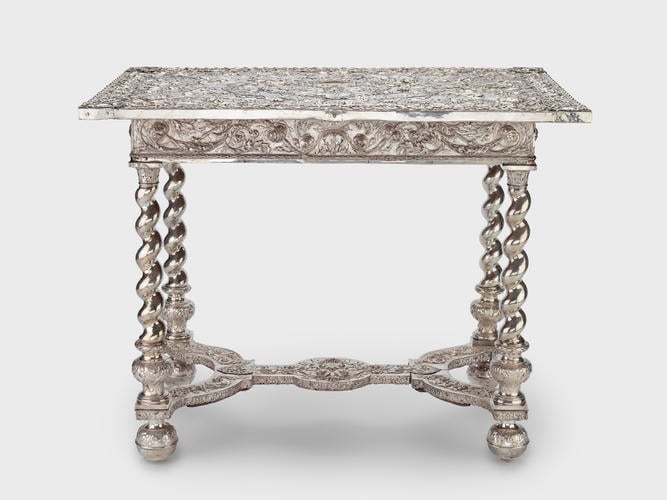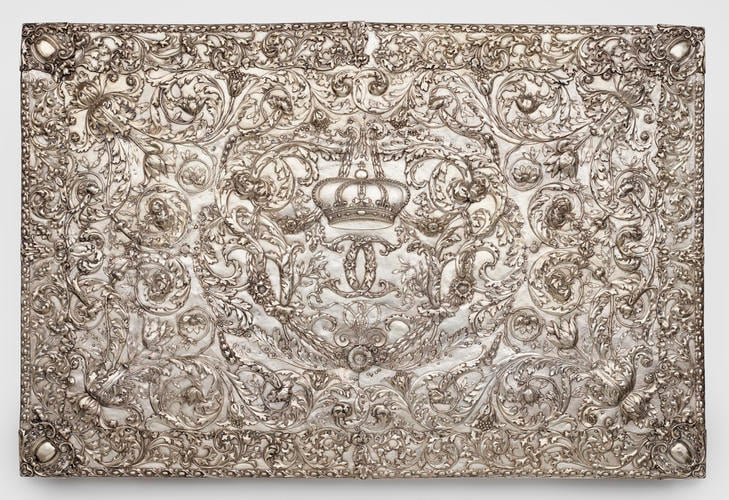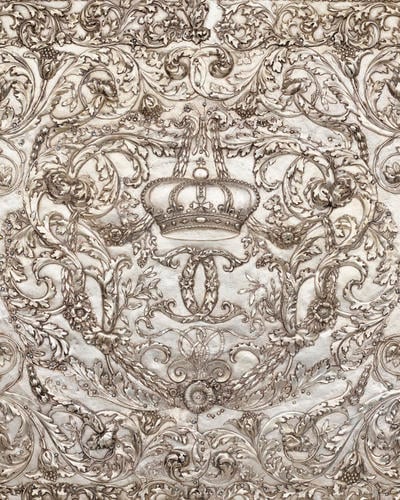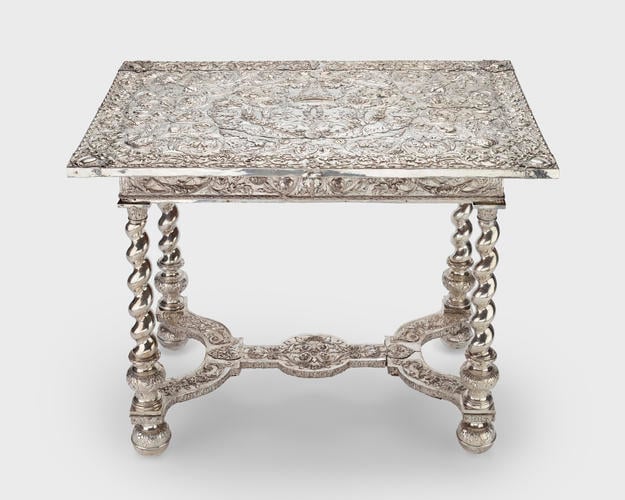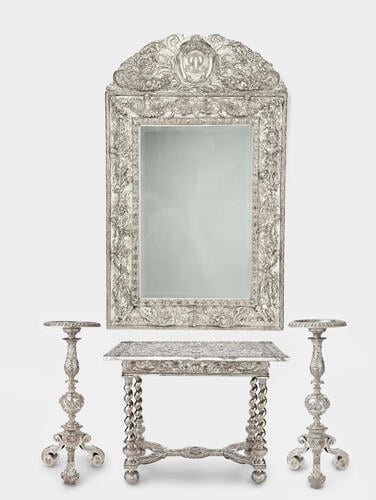-
1 of 253523 objects
Silver table c. 1670
Chased and embossed silver on an oak frame | 87.0 x 106.0 x 70.0 cm (whole object) | RCIN 35299
-
This wooden table is covered with individual silver sheets, which were embossed (repoussé) and chased with the crowned cypher of Charles II, tulips and scrolling acanthus leaves before being pinned in position.
This table, marked with the cipher of Charles II, is testimony to the extravagant vogue for silver furniture that reached its height in England during the decades following the Restoration. From the mid-seventeenth century, European rulers had begun to commission silver furnishings on a grand scale, the most famous being Louis XIV's solid silver furniture at Versailles made by the craftsmen of the Manufactures des Gobelins and the Galeries du Louvres. Such spectacular and obviously costly furnishings played an important role in the creation of magnificence and the representation of power. In the state apartments, the combination of a mirror, table and stands was a static arrangement that was commonly placed against the wall in between two windows. At night, light from candelabra placed on stands would have been reflected into the room by the mirror, while the silver surfaces sparkled and glowed, creating a magnificent visual effect.
While Louis XIV could afford solid silver furniture, Charles II's commissions were largely restricted to the less costly option of a wooden carcase encased in silver to give the effect of a solid piece. The table has been constructed in this way, with finely chased and embossed silver laid over a basic oak structure and secured with pins and bolts.
Bills for silver furnishings purchased by Charles II have not survived, making it impossible to know for certain when or by whom the table was made. The design of the table reflects the influence of Parisian silversmiths such as Claude Ballin and Nicholas de Launay, who supplied silver furniture for Louis XIV at Versailles. On the other hand, there were silversmiths working in England who were capable of such sophisticated workmanship. One possible candidate is John Cooqus (or Cockus), who was appointed 'silversmith in ordinary to his Matie for chastwork within his Maties bedchamber and closet and also the bedchamber of the Queen' in 1667. Cooqus, who was Dutch, is best known as one of the makers of Nell Gwyn's extravagant bed that featured a silver headboard decorated with reliefs of Charles II's head, crowns, cupids and eagles.His other documented commissions include a 12-branch silver chandelier for the queen that cost the enormous sum of £586 19s and a large quantity of chapel plate for Whitehall and Windsor.
The first official reference to silver furniture appears in 1681 when the Jewel House received an order to boil (clean) the silver frames of looking glasses in the queen's state bedchamber at Whitehall.By the time of his death in 1685, Charles II's state bedchamber at Whitehall was also furnished with 'a large silver Looking Glasse, and a large Silver Table with a paire of Large silver stands, a large paire of silver ffire Irons, and a paire of Doggs'. The mirror, table and stands were later given to Mary of Modena for use in her state bedchamber at Whitehall where they appear to have remained until at least 1688. Warrants for cleaning prior to the birth of James II's son in June of that year, record that by this time the king and queen had an impressive quantity of silver furniture including six tables, five mirror frames and ten stands, some of which had almost certainly belonged to Charles II.
Text adapted from Charles II: Art and Power (2017).Provenance
Possibly supplied for Charles II
-
Creator(s)
-
Medium and techniques
Chased and embossed silver on an oak frame
Measurements
87.0 x 106.0 x 70.0 cm (whole object)
Other number(s)
Laking FR : Laking, G.F., 1905. The Furniture of Windsor Castle, London – Laking FR p19,pl.4
